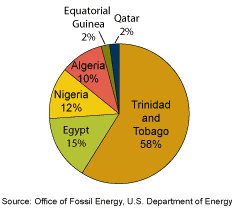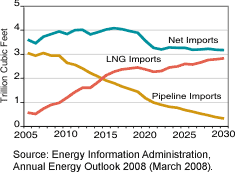


Liquefied natural gas (LNG) is natural gas that has been cooled to about minus 260 degrees Fahrenheit for shipment and/or storage as a liquid. The volume of the liquid is about 600 times smaller than the gaseous form. In this compact form, natural gas can be shipped in special tankers to receiving terminals in the United States and other importing countries. At these terminals, the LNG is returned to a gaseous form and transported by pipeline to distribution companies, industrial consumers, and power plants.
Liquefying natural gas provides a means of moving it long distances where pipeline transport is not feasible, allowing access to natural gas from regions with vast production potential that are too distant from end-use markets to be connected by pipeline.
U.S. LNG Industry Is Expanding
LNG imports to the United States were generally not competitive with domestic supplies of natural gas and pipeline imports from Canada through the 1980s and 1990s, resulting in low levels of these imports during these decades. However, higher natural gas prices in the United States in recent years have attracted larger volumes of LNG imports to this country, including a record U.S. total in 2007 equaling 771 billion cubic feet (Bcf) of natural gas in gaseous form.1 Projected growth in the demand for LNG has resulted in companies adding LNG receiving capacity in the United States. Five LNG import terminals currently operate in the United States. All but one of these has recently expanded. In addition, EIA expects at least four new terminals to be operational in the next two years, more than doubling import capacity from 4.7 Bcf per day at the end of 2006 to over 11 Bcf per day at the end of 2008. This increase in LNG receiving capacity provides the potential for growing U.S. LNG imports in coming years, and EIA projects imports of more than 1 trillion cubic feet of LNG by the end of this decade (see figure, "LNG and Pipeline Import Projection").
Deliveries of LNG from Trinidad and Tobago account for the majority of LNG imports to the United States (see figure, "Sources of LNG Imports to the United States in 2007"). The Atlantic LNG facility located in Port Fortin, Trinidad and Tobago, now produces nearly 700 Bcf a year. In recent years, several African countries, including Egypt, Nigeria, and Algeria, also have been suppliers of LNG to the United States.
Growth in LNG imports to U.S. markets is expected to come from new trading partners, one of which is Equatorial Guinea, where Marathon Oil Corporation has begun operation of an LNG plant on Bioko Island, and deliveries to the United States have recently commenced. Supplies also will likely arrive from the Snohvit LNG project in Norway through a contract with StatoilHydro ASA. In the Middle East, Qatar, the largest LNG exporter in the world, is expected to begin regular deliveries to the United States in the next couple of years. New supplies are expected to come online in Yemen by early 2009, with much of the LNG projected to be delivered to U.S. markets.
Domestic and International Demand for LNG Are Increasing
International LNG trade has grown rapidly in recent years as new export facilities have started operations in several countries. In 2006, 13 countries exported natural gas in the form of LNG to 17 importing countries.2 International trade equaled the equivalent of more than 7.5 trillion cubic feet of natural gas in 2006. By the end of 2010, there will likely be five additional exporting countries for a total of 18 LNG source countries, although not all will be consistent suppliers of LNG to the United States.
The United States is not the only country that is turning to new international sources of natural gas. Countries in Europe and Asia also rely heavily on LNG supplies. By far the largest volume of LNG consumption is in Asia, where Japan and South Korea are the largest importers, accounting for more than 55% of global LNG demand. In Europe, Spain is the largest importer with about 11% of global consumption. Prices in these countries in recent years have surpassed market prices in the United States, resulting in the occasional diversion of cargos from the United States to these countries.
1Office of Fossil Energy, U.S. Department of Energy. Available at: http://www.fe.doe.gov/programs/gasregulation/index.html
2A table showing international LNG trade statistics is available on the EIA web site at: http://www.eia.doe.gov/emeu/international/LNGimp2006.html
